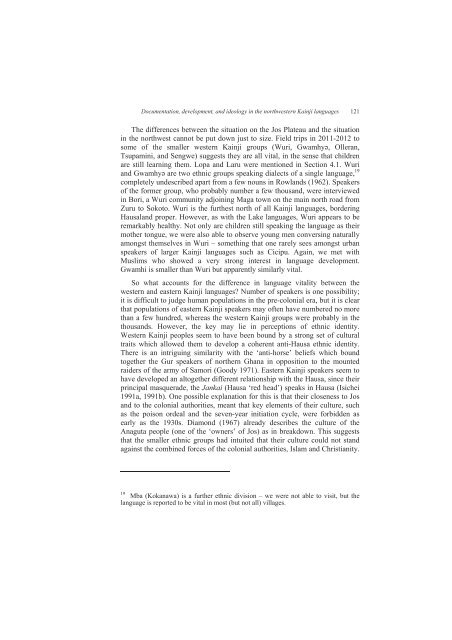Documentation, development, and ideology in the ... - Roger Blench
Documentation, development, and ideology in the ... - Roger Blench
Documentation, development, and ideology in the ... - Roger Blench
You also want an ePaper? Increase the reach of your titles
YUMPU automatically turns print PDFs into web optimized ePapers that Google loves.
<strong>Documentation</strong>, <strong>development</strong>, <strong>and</strong> <strong>ideology</strong> <strong>in</strong> <strong>the</strong> northwestern Ka<strong>in</strong>ji languages 121<br />
The differences between <strong>the</strong> situation on <strong>the</strong> Jos Plateau <strong>and</strong> <strong>the</strong> situation<br />
<strong>in</strong> <strong>the</strong> northwest cannot be put down just to size. Field trips <strong>in</strong> 2011-2012 to<br />
some of <strong>the</strong> smaller western Ka<strong>in</strong>ji groups (Wuri, Gwamhy, Olleran,<br />
Tsupam<strong>in</strong>i, <strong>and</strong> Sengwe) suggests <strong>the</strong>y are all vital, <strong>in</strong> <strong>the</strong> sense that children<br />
are still learn<strong>in</strong>g <strong>the</strong>m. Lopa <strong>and</strong> Laru were mentioned <strong>in</strong> Section 4.1. Wuri<br />
<strong>and</strong> Gwamhy are two ethnic groups speak<strong>in</strong>g dialects of a s<strong>in</strong>gle language, 19<br />
completely undescribed apart from a few nouns <strong>in</strong> Rowl<strong>and</strong>s (1962). Speakers<br />
of <strong>the</strong> former group, who probably number a few thous<strong>and</strong>, were <strong>in</strong>terviewed<br />
<strong>in</strong> Bori, a Wuri community adjo<strong>in</strong><strong>in</strong>g Maga town on <strong>the</strong> ma<strong>in</strong> north road from<br />
Zuru to Sokoto. Wuri is <strong>the</strong> fur<strong>the</strong>st north of all Ka<strong>in</strong>ji languages, border<strong>in</strong>g<br />
Hausal<strong>and</strong> proper. However, as with <strong>the</strong> Lake languages, Wuri appears to be<br />
remarkably healthy. Not only are children still speak<strong>in</strong>g <strong>the</strong> language as <strong>the</strong>ir<br />
mo<strong>the</strong>r tongue, we were also able to observe young men convers<strong>in</strong>g naturally<br />
amongst <strong>the</strong>mselves <strong>in</strong> Wuri – someth<strong>in</strong>g that one rarely sees amongst urban<br />
speakers of larger Ka<strong>in</strong>ji languages such as Cicipu. Aga<strong>in</strong>, we met with<br />
Muslims who showed a very strong <strong>in</strong>terest <strong>in</strong> language <strong>development</strong>.<br />
Gwamhi is smaller than Wuri but apparently similarly vital.<br />
So what accounts for <strong>the</strong> difference <strong>in</strong> language vitality between <strong>the</strong><br />
western <strong>and</strong> eastern Ka<strong>in</strong>ji languages? Number of speakers is one possibility;<br />
it is difficult to judge human populations <strong>in</strong> <strong>the</strong> pre-colonial era, but it is clear<br />
that populations of eastern Ka<strong>in</strong>ji speakers may often have numbered no more<br />
than a few hundred, whereas <strong>the</strong> western Ka<strong>in</strong>ji groups were probably <strong>in</strong> <strong>the</strong><br />
thous<strong>and</strong>s. However, <strong>the</strong> key may lie <strong>in</strong> perceptions of ethnic identity.<br />
Western Ka<strong>in</strong>ji peoples seem to have been bound by a strong set of cultural<br />
traits which allowed <strong>the</strong>m to develop a coherent anti-Hausa ethnic identity.<br />
There is an <strong>in</strong>trigu<strong>in</strong>g similarity with <strong>the</strong> ‘anti-horse’ beliefs which bound<br />
toge<strong>the</strong>r <strong>the</strong> Gur speakers of nor<strong>the</strong>rn Ghana <strong>in</strong> opposition to <strong>the</strong> mounted<br />
raiders of <strong>the</strong> army of Samori (Goody 1971). Eastern Ka<strong>in</strong>ji speakers seem to<br />
have developed an altoge<strong>the</strong>r different relationship with <strong>the</strong> Hausa, s<strong>in</strong>ce <strong>the</strong>ir<br />
pr<strong>in</strong>cipal masquerade, <strong>the</strong> Jankai (Hausa ‘red head’) speaks <strong>in</strong> Hausa (Isichei<br />
1991a, 1991b). One possible explanation for this is that <strong>the</strong>ir closeness to Jos<br />
<strong>and</strong> to <strong>the</strong> colonial authorities, meant that key elements of <strong>the</strong>ir culture, such<br />
as <strong>the</strong> poison ordeal <strong>and</strong> <strong>the</strong> seven-year <strong>in</strong>itiation cycle, were forbidden as<br />
early as <strong>the</strong> 1930s. Diamond (1967) already describes <strong>the</strong> culture of <strong>the</strong><br />
Anaguta people (one of <strong>the</strong> ‘owners’ of Jos) as <strong>in</strong> breakdown. This suggests<br />
that <strong>the</strong> smaller ethnic groups had <strong>in</strong>tuited that <strong>the</strong>ir culture could not st<strong>and</strong><br />
aga<strong>in</strong>st <strong>the</strong> comb<strong>in</strong>ed forces of <strong>the</strong> colonial authorities, Islam <strong>and</strong> Christianity.<br />
19<br />
Mba (Kokanawa) is a fur<strong>the</strong>r ethnic division – we were not able to visit, but <strong>the</strong><br />
language is reported to be vital <strong>in</strong> most (but not all) villages.
















